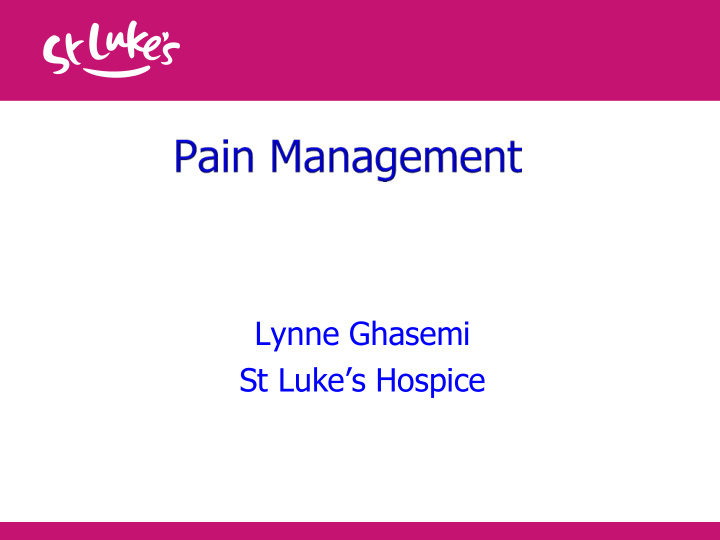



Enhanced Community Palliative Support Services Lynne Ghasemi St Luke’s Hospice
Learning Outcomes Define the different types of pain Describe the process of pain assessment Discuss pharmacological management of pain Identify non pharmacological approaches for pain management.
What is pain? What is pain? Pain is an unpleasant sensory and emotional experience associated with actual or potential tissue damage ‘Pain is whatever the patient says it is and exists whenever he says it does’ Pain assessment is essential in the management of pain
Total Pain Physical - pain of the disease process Psychological/Social – financial/body image/family Emotional -loss of independence/fear of death Spiritual – low self esteem /dignity
Types of Pain Soft Tissue Throbbing/tender/ache Oedema Heavy/tight Nerve Throbbing/burning/toothache Raised intracranial pressure Thumping restricting Bone Gnawing/aching Colic Cramping/exhausting/gripping
Pain Assessment Location Duration Description What decreases pain What increases pain Intensity How does the patient respond Pain Tools
Pain Assessment Tools Visual analogue scale Numerical Scale Verbal rating scale McGill pain questionnaire Faces Pain Scale Body Picture Distat Tool
Principles in Managing Pain Right Drug by the Ladder Right dose by mouth/patch/injection Right Time by clock
Step 1 Non Opiates +/- Adjuvant Paracetamol Aspirin (rarely used in end of life)
Step 2 Weak opiates +/- Adjuvant Co Codamol Codeine Dihydrocodeine Kapake Tramodol Nefopam Buprenorphine patch
Step 3 Strong Opiates +/- Adjuvant • Morphine I/R or S/R • Diamorphine I/R • Oxycodone I/R or S/R • Fentanyl Patch S/R • Buprenorphine patch • SL or Buccal IR fentanyl • Methadone I/R but long half life • I/R immediate release S/R slow release
Nociceptive Pain • Soft tissue, bone or joint disease, pelvic disease or originating in renal tract or retroperitoneal – NSAIDs with PPI cover • Metastatic bone pain – NSAIDs or COX2 + adjuvant-seek specialist advice • Muscle spasm – Diazepam 2mg PO tds or Baclofen 5mg PO tds • Intestinal colic – Antispasmodics e.g. Mebeverine 135mg PO tds or Hyoscine butylbromide 20mg sc qds or CSCI – see specialist advice • Liver capsule pain – NSAIDS or Dexamethazone 4mg PO od for 5 day trial (if continued monitor blood sugars weekly)
Neuropathic Pain • Infiltration by tumour, zoster, scar tissue or compression unrelieved by steroid or specific therapies • Amitriptyline/Nortriptyline 10-75mg • Gabapentin 300-3600mg/day (divided twice daily • Pregabalin 25-600mg/day (twice daily dosing) • Capsaicin 0.075% cream applied sparingly up to qds • Clonazepam 125mcg – 4mg /day PO/SC in divided doses • Methadone*/Ketamine* for complex pain not responsive to other regimes • *Both require specialist intervention/monitoring due to complexities of these drugs
Neuropathic pain • Compression by tumour – Dexamethazone 4mg PO od (monitor blood sugars weekly) • Diabetic neuropathy – Duloxetine 30mg PO OD titrating to 60mg bd
Adjuvant Analgesics Drug Class Type of Pain Drug names Anticonvulsant/Antidepressant Neuropathic – Injury peripheral pregabalin, gabapentin, or CNS e.g. Nerve infilltration Carbamazepine, amitriptyline, nortryptyline, duloxetine Muscle relaxants Muscle spasm diazepam, baclofen Steroids Nerve compression, swelling, dexamethasone raised ICP NSAIDs Somatic e.g. bone pain or Ibuprofen, Naproxen, visceral e.g. Liver pain Diclofenac Antispasmodics Intestinal Colic Mebeverine 135mg po tds, Hyoscine butylbromide sc, Monoclonal antibody Bone Pain Denosumab Bisphosphonates Bone Pain zolendronic acid Anaesthetics Cancer pain, neuropathic pain Nerve blocks, ketamine, intrathecal, lidocaine patches Antibiotics Infection
Non Drug Pain Relief • Heat • Cold • Relaxation • Divisional Therapy • Tens • Acupuncture • Radiotherapy • Immobilisation/aids • Surgical intervention
What factors increase or decrease pain? Increase Pain Decrease Pain Insomnia, fatigue Sleep Anxiety, fear Relaxation Depression Elevation of mood Social isolation Companionship, understanding Discomfort Relief of other symptoms
Breakthrough Cancer Pain (BTcP) • Predictable pain e.g. dressing change, movement (walking, coughing) • Unpredictable (spontaneous) pain e.g idiopathic no known cause
Treatment of BTcP Correct the Non-drug correctable Drug Treatment
Fentanyl • Fentanyl patches (brands: Durogesic D – Trans, Matrifen, Mezolar) matrix or reservoir • Tablets: Sub lingual Abstral, Buccal Effentora • Lozenges: Actiq • Nasal spray: Instanyl, PecFent • Alfentanyl parenteral injections
Fentanyl Patches • When patch is initiated it will take 12-18 hours for full absorption. • If converting from SR alternative opiate, commence patch at the same time as last 12 hourly SR tablet is given. • When patch strength is increased it will again need 12- 18 hours for the medication to reach absorption. • Patient may still require rescue doses of immediate release opiates. • Levels peak at 24-72 hours
Risks associated with fentanyl • Fentanyl is a strong opioid and should not be commenced on opioid naïve patients. • It is a slow releasing opioid so there is risk of respiratory depression if not administered correctly. • Direct heat can increase the absorption (heat pads, hot water bottle etc) • Risk of abuse. • If administered by nurses record on a green card • Report incidents to Locality Manager
Side effects of opioids • Nausea &/or vomiting warn pt and prescribe prn antiemetic • Constipation – prophylactic laxatives • Cognitive impairment, drowsiness, myoclonic jerks, dysphoria, respiratory depression dose related side effects indicating need to reduce opioid dose, review adjuvants and substitute opioid • Acute respiratory depression/bradypnoea. Give Naloxone 100mcg - 2mg by slow IV injection titrated against resps avoiding complete reversal of analgesia if possible. • Refractory pain – pts with unresponsive pain or opioid toxicity may need to be referred to the Palliative Care Service.
Conclusion • Pain affects quality of life • Patients have the right to be pain free • Continual and effective assessment is essential for successful pain management • Pharmacological and non pharmacological methods should be used in treatment. • Correct medication for pain type • Be aware of contraindications/ renal impairment
Further information • NICE guidance on opioids for pain in palliative care (May 2012 – reviewed May 2014) • NICE guidance on neuropathic pain (2010) • PCF5 (2015) – www.palliativedrugs.com • Clinical Knowledge Summaries http://www.cks.nhs.uk/palliative_cancer_care_pain/mana gement • Sheffield palliative care formulary version 4
Recommend
More recommend